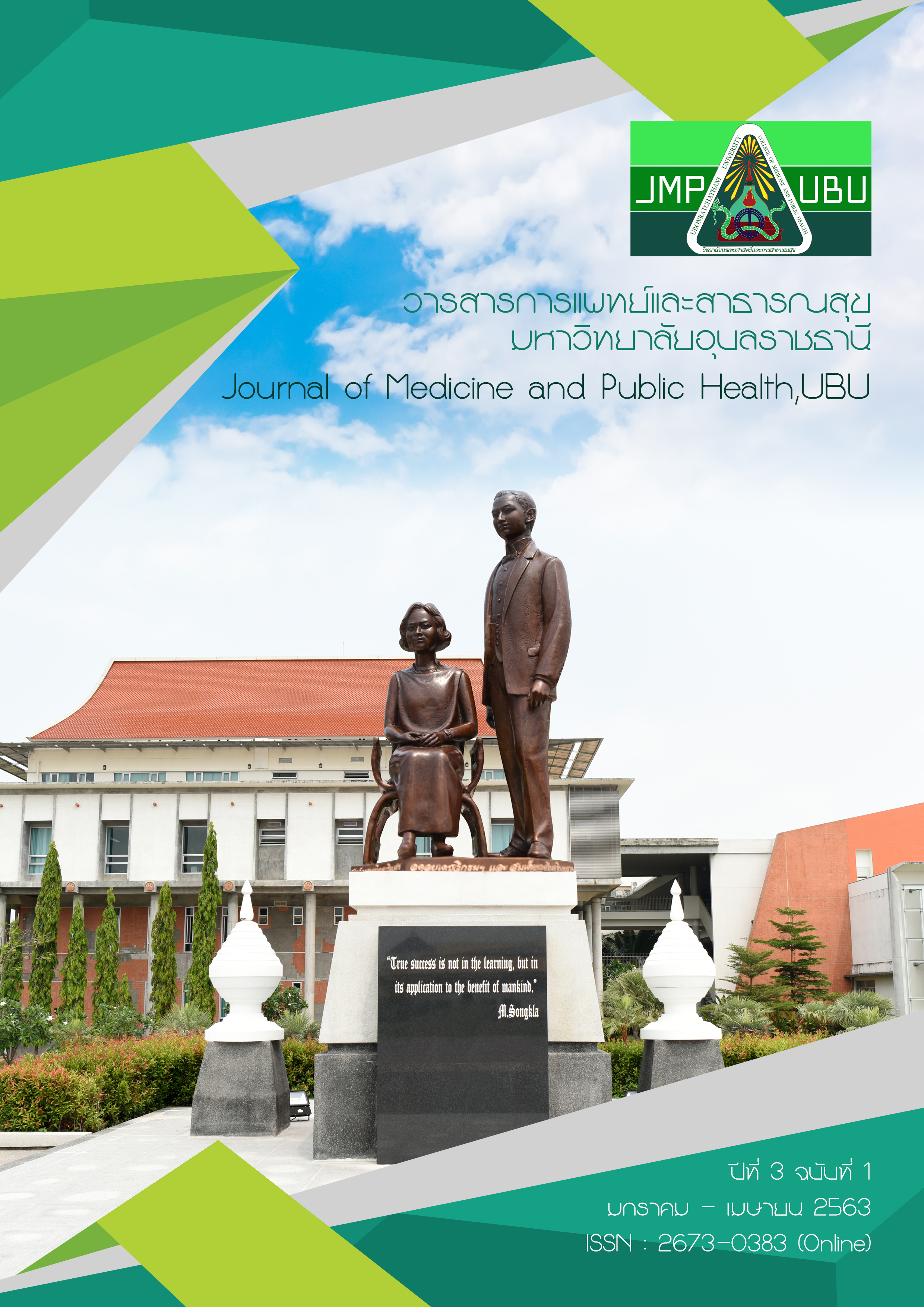ปัจจัยที่มีความสัมพันธ์กับการติดเชื้อในกระแสเลือดของทารกแรกคลอดในโรงพยาบาลสตูล
คำสำคัญ:
โรคติดเชื้อในกระแสเลือด, ทารกแรกคลอด, โรงพยาบาลบทคัดย่อ
การศึกษาครั้งนี้มีวัตถุประสงค์เพื่อศึกษาปัจจัยที่มีความสัมพันธ์กับโรคติดเชื้อในกระแสเลือดของทารกแรกคลอดในโรงพยาบาลสตูล ผลการศึกษาพบว่า ปัจจัยที่มีความสัมพันธ์กับโรคติดเชื้อในกระแสเลือดของทารกแรกคลอด คือ น้ำหนักทารกแรกคลอด การรักษาพยาบาลด้วยเครื่องช่วยหายใจ การรักษาตัวในห้อง ICU ทารกแรกคลอดที่เกิดจากมารดาที่มีภาวะไข้ และทารกแรกคลอดที่เกิดจากมารดาที่มีภาวะภาวะถุงน้ำคร่ำแตกก่อนอายุครรภ์จะครบ 37 สัปดาห์ โดยเฉพาะทารกแรกคลอดที่เกิดจากมารดาที่มีภาวะไข้ในโรงพยาบาล กลุ่มนี้มีโอกาสเสี่ยงที่จะป่วยด้วยโรคติดเชื้อในกระแสเลือด ร้อยละ 16.3 (95% CI=7.4 – 30.7, P-value=0.01) ดังนั้นการเฝ้าระวังการติดเชื้อในกระแสเลือดของทารกแรกคลอด ควรเริ่มโปรแกรมทันทีหลังจากที่แพทย์ทำการตรวจสอบอุณหภูมิของร่างกายในมารดา ซึ่งจะช่วยลดความเสี่ยงของการติดเชื้อในกระแสเลือดของทารกแรกคลอดในโรงพยาบาลสตูล
Downloads
เอกสารอ้างอิง
Giannoni E, Agyeman PK, Stocker M, Posfay-Barbe KM, Heininger U, Spycher BD, et al. Neonatal sepsis of early onset, and hospital-acquired and community-acquired late onset: a prospective population-based cohort study. J Pediatr. 2018; 201:106-114.
UNICEF. The neonatal period is the most vulnerable time for a child. March 2018 [online]. แหล่งข้อมูล https://data.unicef.org/ topic/child-survival/neonatal-mortality/ [เข้าถึงเมื่อ 19 เมษายน 2563].
Seale AC, Blencowe H, Manu AA, Nair H, Bahl R, Qazi SA, et al. Estimates of possible severe bacterial infection in neonates in sub-Saharan Africa, south Asia, and Latin America for 2012: a systematic review and meta-analysis. Lancet Infect Dis. 2018; 14(8): 731-741.
Tariq P, Kundi Z. Determinants of neonatal mortality. Journal of Pakistan Medical Association 1999; 49(3): 56-59.
Upadhyay RP, Dwivedi PR, Rai SK, Misra P, Kalaivani M, Krishnan A. Determinants of neonatal mortality in rural Haryana: a retrospective population based study. Indian Pediatr. 2012; 49(4): 291-294.
Yismaw AE, Abebil TY, Biweta MA, Araya BM. Proportion of neonatal sepsis and determinant factors among neonates admitted in University of Gondar comprehensive specialized hospital neonatal Intensive care unit Northwest Ethiopia 2017. BMC Res Notes. 2019; 12: 542.
The Global Maternal and Neonatal Sepsis Initiative Working Group. The Global Maternal and Neonatal Sepsis Initiative: a call for collaboration and action by 2030. Lancet. Glob Health. 2017; 5(4): e390-e391.
Reinhart K, Daniels R, Kissoon N, Machado FR, Schachter RD, et al. Recognizing sepsis as a global health priority—a WHO resolution. N Engl J Med. 2017; 377(5):414-417.
Shane AL, Sánchez PJ, Stoll BJ. Neonatal sepsis. The Lancet 2017; 390(10104): 1770-1780.
Singh SJ, Fraser A, Leditschke JF, Spence K, Kimble R, Dalby-Payne J, et al. Gastroschisis: determinants of neonatal outcome. Pediatr Surg Int. 2003; 19(4): 260-265.
Wynn JL, Guthrie SO, Wong HR, Lahni P, Ungaro R, Lopez MC, et al. Postnatal age is a critical determinant of the neonatal host response to sepsis. Mol Med. 2015; 21(1): 496-504.
Biesheuvel CJ, Vergouwe Y, Oudega R, Hoes AW, Grobbee DE, Moons KG. Advantages of the nested case-control design in diagnostic research. BMC Med Res Methodol. 2008; 8(1): 48.
Tongkumchum P, Saelim R, Makaje N, Phon-On A. Democratic Confidence Intervals for comparing two Proportions. Songklanakarin J. Sci. Technol. 2013; 35(2): 235-241.
Alemu M, Ayana M, Abiy H, Minuye B, Alebachew W, Endalamawet A. Determinants of neonatal sepsis among neonates in the northwest part of Ethiopia: case-control study. Italian journal of pediatrics 2019; 45(1): 150.
Murthy S, Godinho MA, Guddattu V, Lewis LES, and Nair NS. Risk factors of neonatal sepsis in India: A systematic review and meta-analysis. PloS one 2019; 14(4): e0215683.
Al-Taiar A, Hammoud MS, Cuiqing L, Lee JK, Lui KM, Nakwan N, et al. Neonatal infections in China, Malaysia, Hong Kong and Thailand. Arch Dis Child Fetal Neonatal Ed. 2013; 98(3): 249-255.
Thatrimontrichai A, Chanvitan P, Janjindamai W, Dissaneevate S, Jefferies A, Shah V. Brief communication (Original). Trends in neonatal sepsis in a neonatal intensive care unit in Thailand before and after construction of a new facility. Asian Biomedicine 2017; 8(6): 771-778.
Villanueva-Uy ME, Wongsiridej P, Sangtawesin V, Chiu V, Tallo V, Nazaire-Bermal N, et al. The burden of invasive neonatal group B streptococcal (GBS) disease in Thailand and the Philippines. Southeast Asian J Trop Med Public Health 2015; 46(4): 728-737.
Mohseny AB, van Velze V, Steggerda SJ, Smits-Wintjens VEHJ, Bekker V, Lopriore E. Late-onset sepsis due to urinary tract infection in very preterm neonates is not uncommon. Eur J Pediatr. 2018; 177(1): 33-38.
Afonso EDP, Blot S. Effect of gestational age on the epidemiology of late-onset sepsis in neonatal intensive care units-a review. Expert Rev Anti Infect Ther. 2017; 15(10): 917-924.
ดาวน์โหลด
เผยแพร่แล้ว
รูปแบบการอ้างอิง
ฉบับ
ประเภทบทความ
สัญญาอนุญาต
เนื้อหาและข้อมูลในบทความที่ลงตีพิมพ์ในวารสารการแพทย์และสาธารณสุข มหาวิทยาลัยอุบลราชธานี ถือเป็นข้อคิดเห็นและความรับผิดชอบของผู้เขียนบทความโดยตรง ซึ่งกองบรรณาธิการวารสารไม่จำเป็นต้องเห็นด้วย หรือร่วมรับผิดชอบใด ๆ
บทความ ข้อมูล เนื้อหา รูปภาพ ฯลฯ ที่ได้รับการตีพิมพ์ในวารสารการแพทย์และสาธารณสุข มหาวิทยาลัยอุบลราชธานี ถือเป็นลิขสิทธิ์ของวารสารการแพทย์และสาธารณสุข มหาวิทยาลัยอุบลราชธานี กองบรรณาธิการไม่สงวนสิทธิ์ในการคัดลอกเพื่อการพัฒนางานด้านวิชาการ แต่ต้องได้รับการอ้างอิงที่ถูกต้องเหมาะสม






